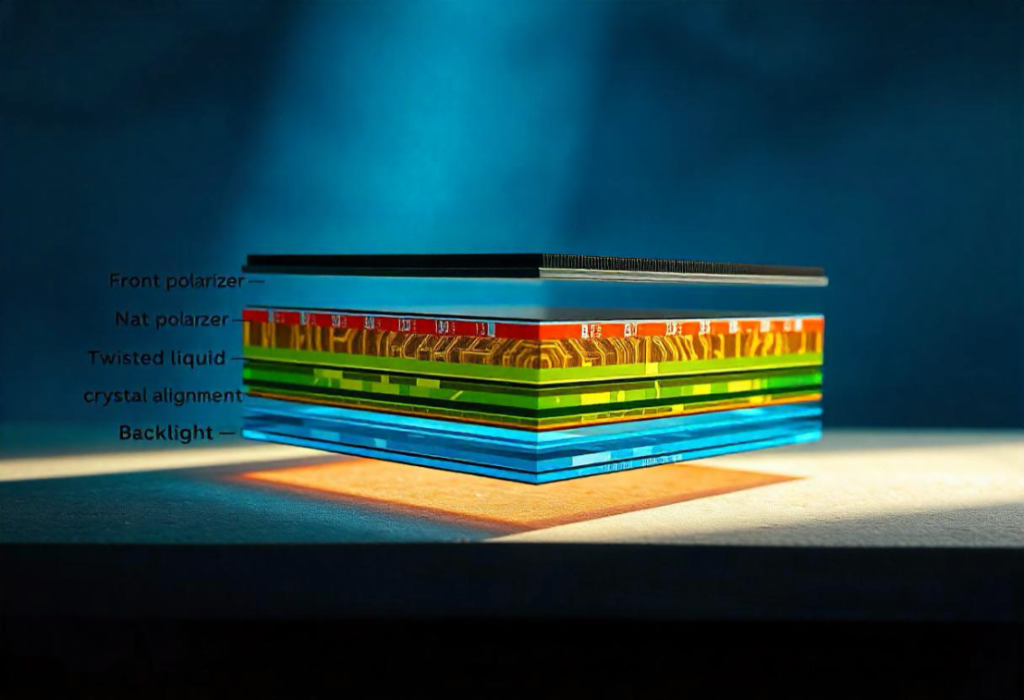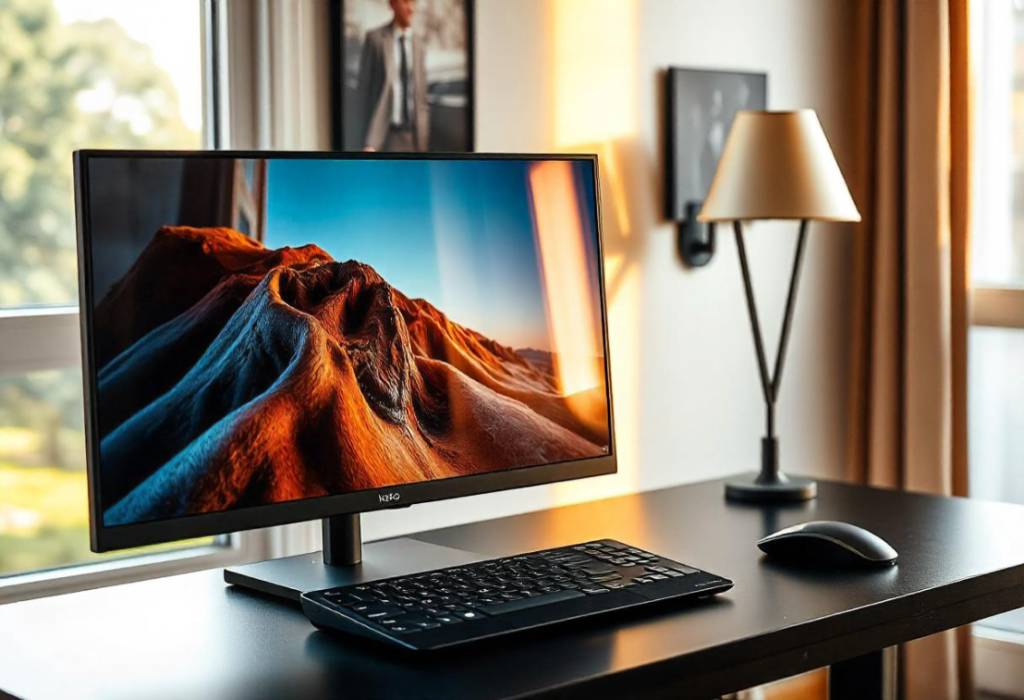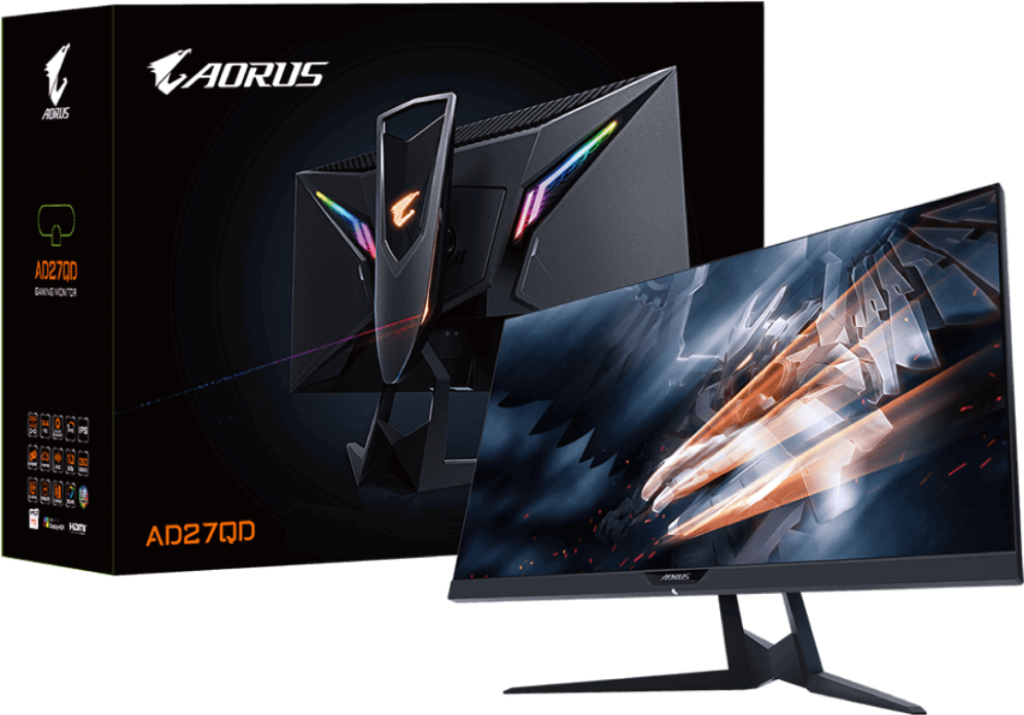Introduction
Let’s explore the types of LCD display technology in detail.

In This Article:
- Introduction
- What are the Different Types of LCD Display
- Twisted Nematic (TN) LCD Display
- Vertical Alignment (VA) LCD Display
- In-Plane Switching (IPS) LCD Display
- STN (Super Twisted Nematic) LCD
- FAQs
- Bottom Line
What are the Different Types of LCD Display?
Liquid crystal displays are market-dominant for their lightweight, small size, efficiency, wide viewing angles, thin design, no flickering, and matchability with the CMOS IC.The following is a detailed discussion of the different types of LCD display.
Twisted Nematic (TN) Display
The twisted nematic LCD is a monochromic display technology. It can be used as a positive-negative screen. A twisted nematic (TN) display consists of two polarized filters with a layer of nematic liquid crystal sandwiched between glass substrates.
When electricity is applied, light passes through the first polarizer and enters the nematic liquid crystal, causing the light to rotate its angle by 90 degrees.
The light travels through the back glass to reach the back polarizer. This process enables the TN LCD technology to turn on and off, allowing us to see the image. It is one of the traditional display technologies with many advantages and disadvantages.

Advantages of TN LCDs:
- Fast Response Times:TN displays have the minimum response time of all LCD displays. They are ideal for gaming and fast-moving video play.
- High Refresh Rate:The display comes with a high refresh rate. It can change images with a new image more quickly.
- Cost-Effective:The panels are generally more affordable than the VA and IPS panels. If you are a budget-conscious guy, TN is for you.
- Energy Efficiency:TN displays are energy efficient. They consume less power than IPS displays. Even you can easily power your TN display using batteries or low-power sources.
- Simple Design:The displays need fewer additional components and are released in a simple design.
Disadvantages of TN LCDs:
- Limited Viewing Angles:TN displays offer limited viewing angles, resulting in noticeable color and contrast shifts when viewed from different angles.
- Color Accuracy:The TN displays have less accurate color reproduction.
- Contrast Ratio:It has a lower contrast ratio than the IPS display.
Application of TN Display
TN displays are used in industrial equipment, competitive gaming devices, consumer electronics, feature phones, calculators, etc.
Vertical Alignment (VA) Display
The other name of the VA panels is Multi-Domain Vertical Alignment(MVA). The displays provide the combined features of IPS and TN displays. When electricity is applied to the VA display the pixels align in the same direction as the glass substrate and pass the light.
Following are the pros and cons of the VA panels.
Advantages of VA Display:
- High Contrast Ratios:It has a higher contrast ratio than other LCD technologies between 2500:1 and 4000:1. It delivers deeper blacks and better contrast to enhance movie and video viewing experiences.
- Better Color Reproduction:The VA panels have better color reproduction than TN panels. It may exceed the standard RGB and reach the Adobe RGB color gamut.
- Viewing Angles:These display panels have wide viewing angles of up to 178 degrees. You can enjoy clear pictures and videos from every corner of your house in this display panel.
- Fast Refresh Rate:VA displays have a fast refresh rate between 60 Hz and 120 Hz.
- Versatility:The VA displays are versatile. They are suitable for bright sunlight and low-light environments.
Disadvantages of VA Display:
- Slower Response Times:The panels have a slower refresh which may experience motion blur in fast-paced content play.
- Uneven Lighting:The VA displays require backlighting to illuminate the pixels. Hence some bright and some dimming areas may appear on the VA screen.
Application of VA Display
The VA display technology is used in televisions, gaming displays, creative work displays like photo and video editing, offices, and digital signage.
In-Plane Switching (IPS) Display
The In-Plane switching display works on the existing liquid crystals of the display technology to boost the image quality. When the electricity is applied in the IPS panel, the liquid crystals move around in-plane or parallel to pass the light.

Advantages of In-Plane Switching(IPS) Display
- Superior Color Accuracy:The IPS displays have live-like color accuracy. They deliver consistent and accurate colors, making them ideal for the tasks such as graphic design and broadcasting.
- Wide Viewing Angles:This display has wide viewing angles. It can maintain perfect image quality even when viewed from different angles.
- Color Consistency:The color consistency of the displays is much superior to the TN display. They can show 256 shades of each primary color whereas TN displays show only 64 shades.
- Better Contrast Ratio:IPS displays have a better contrast ratio than other older LCD technologies.
- Stability:The IPS display technology is more reliable and stable.
Disadvantages of In-Plane Switching(IPS) Display
- Slower Response Times:IPS panels may not be as responsive as TN panels which may impact the ability to play fast-paced games.
- Higher Power Consumption:This display technology consumes more power(15%) and impacts the battery life of portable devices.
Application of IPS Display
IPS displays are popular for their color accuracy and wide viewing angles. Hence they are widely used for graphic design, gaming, business professionals, data analysis, medical imaging, digital signage, etc.
STN (Super Twisted Nematic) LCD
The STN is an LCD type that uses a twisted nematic liquid crystal layer with a broad twist angle of 180-270 degrees. The twist angle of STN is much greater than traditional LCDs. So the name is super twisted nematic.
The liquid crystal molecules of STN LCD are aligned in a twisted configuration inside the glass substrates. When electricity is applied, the liquid crystal molecules align with the electric field and rotate the twisted configuration.
This rotation of the twisted configuration determines how the light passes through the polarizing filters and changes the light intensity to create images.
Advantages STN (Super Twisted Nematic) LCD
- Better Contrast Ratio:It has a better contrast ratio with a big difference in light and dark color.
- Wide Viewing Angles:STN LCDs have wide twist angles and viewing angles.
- High Resolution:The display has a high multiplex rate to ensure higher resolution.
- Sunlight Performance:The STN displays are suitable for seeing under the sunlight for their reflective nature.
- Power Efficiency:These LCD displays consume less power than the other display technology.
Disadvantages STN (Super Twisted Nematic) LCD
The STN displays have some drawbacks such as:
- Costlier:The STN displays are more costlier display technology due to the complexity of production.
- Slower Response Rate:They are slower than other display technologies.
Application Of STN Display
STN displays are used in watches, calculators, electronic devices, industrial control panels, automotive displays, etc.
This is the sum up of your main discussion on types of LCD display, but not the end.

Frequently Asked Questions (FAQs)
Following FAQs on types of LCD display will give you more clearer conception.
What display type is the best?
The best type of display is OLED. Although OLED displays contain LED technology, they are distinct from traditional LED displays. OLED stands for organic light-emitting diode, which uses organic materials, like carbon, to produce light.
How many types of display technology are there?
There are different display technologies available in the market for example:
- LCD (Liquid Crystal Display)
- OLED (Organic Light Emitting Diodes)
- LED (Light-Emitting Diode)
- Plasma Display
- Electronic Paper Display
- CRT (Cathode Ray Tube) Display
- and E-link Display.
What is the best LCD technology?
The IPS LCD is the best LCD type display with numerous advantages and features. It provides consistent and accurate color with wide viewing angles.
What is the new technology for LCD?
The QLED(Quantum Light Emitting Diode) is the new LCD technology. It uses small semiconductor elements called quantum dots to increase the quality and performance of conventional LCDs.
What is LCD backlight technology?
The LCD backlight technology provides the necessary light to illuminate the display and make the images visible. The LCD panels do not create light itself. They depend on the backlight technology to be enlightened through the liquid crystal layer.
Bottom Line
LCD technology is one of the most potential and traditional displays with many variations from the oldest TN to the latest IPS. Each LCD display has its strengths and weaknesses. They are suitable for various applications in different commercial and consumer electronic items.
We hope different types of LCD display will be more accurate and high-performance in the near future. Stay with us to learn new display technology.
